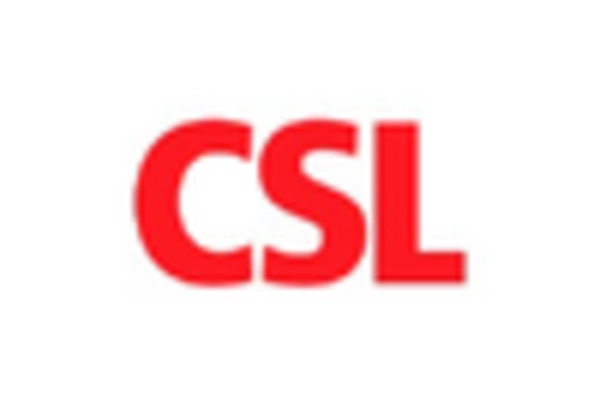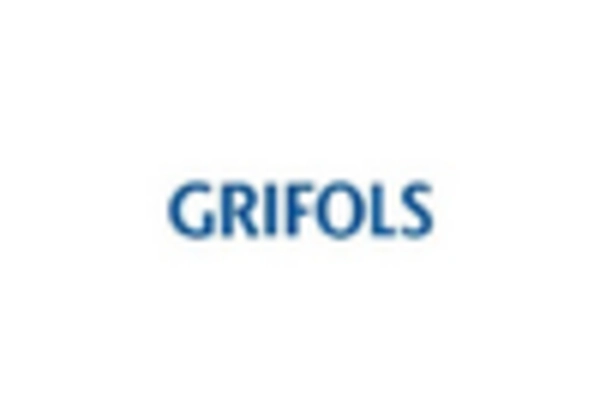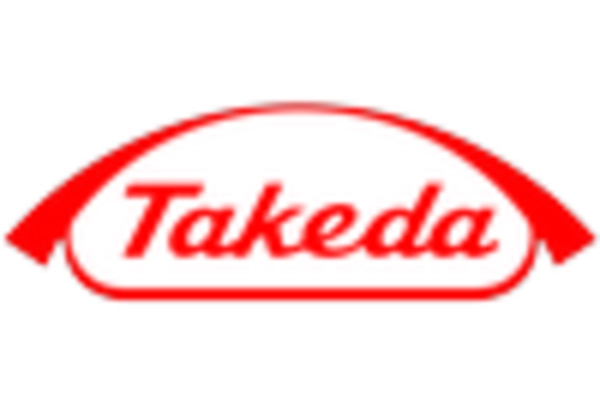Surge in Chronic Diseases
The prevalence of chronic diseases in China is escalating, which significantly impacts the plasma fractionation market. Conditions such as hemophilia, immune deficiencies, and liver diseases are becoming more common, necessitating effective treatment options. According to recent statistics, approximately 10 million individuals in China suffer from hemophilia, creating a substantial demand for clotting factor concentrates. This surge in chronic diseases indicates a growing need for plasma-derived therapies, thereby driving the plasma fractionation market. As healthcare providers seek to address these health challenges, the reliance on plasma products is likely to increase. This trend may lead to enhanced research and development efforts aimed at improving plasma fractionation techniques, ultimately benefiting patients who require these life-saving treatments.
Increasing Healthcare Expenditure
The rising healthcare expenditure in China is a pivotal driver for the plasma fractionation market. As the government allocates more funds towards healthcare, the demand for plasma-derived therapies is likely to increase. In 2023, healthcare spending in China reached approximately $1.2 trillion, reflecting a growth rate of around 10% annually. This trend suggests that more resources will be directed towards advanced medical treatments, including immunoglobulins and clotting factors derived from plasma. Consequently, the plasma fractionation market is expected to benefit from this increased investment, as healthcare facilities expand their capabilities to provide essential therapies. Furthermore, the growing awareness of plasma-derived products among healthcare professionals and patients may further stimulate market growth, as these therapies are crucial for treating various medical conditions.
Expansion of Plasma Collection Centers
The establishment of new plasma collection centers across China is a crucial driver for the plasma fractionation market. In recent years, the government has encouraged the development of these centers to ensure a steady supply of plasma for therapeutic use. As of 2025, there are over 200 licensed plasma collection facilities in China, with plans for further expansion. This growth is essential for meeting the rising demand for plasma-derived products, as it enhances the availability of raw materials for fractionation processes. The plasma fractionation market stands to gain from this expansion, as increased plasma collection directly correlates with the production of immunoglobulins and other critical therapies. Moreover, public awareness campaigns promoting plasma donation are likely to bolster the supply chain, ensuring that the market can sustain its growth trajectory.
Regulatory Support for Plasma Products
Regulatory support for plasma-derived products in China is a vital driver for the plasma fractionation market. The government has implemented favorable policies to streamline the approval process for new therapies, ensuring that safe and effective plasma products reach the market more efficiently. Recent regulatory reforms have reduced the time required for clinical trials and product approvals, which is likely to encourage investment in the plasma fractionation market. As a result, pharmaceutical companies may be more inclined to develop innovative therapies based on plasma proteins. This supportive regulatory environment not only enhances market accessibility but also fosters competition among manufacturers, potentially leading to improved product offerings for patients. The ongoing commitment to regulatory excellence is expected to sustain the growth of the plasma fractionation market in the coming years.
Advancements in Research and Development
Ongoing advancements in research and development within the plasma fractionation market are driving innovation and efficiency. Chinese research institutions and pharmaceutical companies are increasingly investing in R&D to enhance fractionation technologies and improve product yields. For instance, novel purification techniques and automated processes are being explored to optimize the extraction of valuable plasma proteins. This focus on innovation is expected to lead to higher-quality products and reduced production costs, thereby benefiting the plasma fractionation market. Furthermore, collaborations between academic institutions and industry players are fostering a conducive environment for breakthroughs in plasma therapies. As these advancements materialize, they may significantly enhance the therapeutic options available to patients, ultimately contributing to the market's growth.

















Leave a Comment